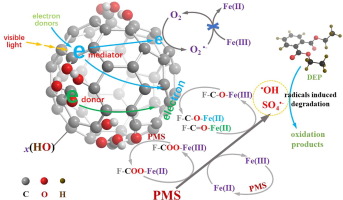Chemical Engineering Journal ( IF 13.3 ) Pub Date : 2020-01-18 , DOI: 10.1016/j.cej.2020.124126 Peng Zhou , Xiaowei Huo , Jing Zhang , Yang Liu , Feng Cheng , Xin Cheng , Yunqi Wang , Yongli Zhang

|
Hydroxylated fullerene (fullerenol) has gained increasing attention in the field of water environment remediation based on its intrinsic properties of photosensitivity and high water solubility. In this work, C60 fullerenol was added to the Fe(III)/PMS process to enhance diethyl phthalate (DEP) degradation both with and without visible light. The DEP removal ratio was increased from 2.2% to 58.8% with the addition of fullerenol at 60 min in dark condition, and the removal of DEP was completely achieved within 50 min under visible light irradiation. Mechanism investigation shows that carboxyl and carbonyl were formed via keto-enol isomerization at acid condition, resulting in the formation of open-cage fullerenol. The open-cage fullerenol can act as complex agent and electron donor to enhance oxidizing capability of the Fe(III)/PMS process by promoting Fe(III)/Fe(II) cycles. Competitive radical capture tests by electron spin resonance (ESR) and radical quenching analysis demonstrate that hydroxyl radical and sulfate radical were primarily responsible for DEP removal, but not superoxide radical and singlet oxygen. The DEP removal in the F/Fe(III)/PMS process is more efficiency at initial pH ranging from 2.1 to 4.9. Moreover, the DEP degradation route was proposed involving the generation of various intermediary products. This study provides a novel method for the application of fullerene derivatives on environment remediation by combining with metal catalyzed advanced oxidation processes.
中文翻译:

可见光诱导的Fe(III)/ Fe(II)循环加速,以增强C 60富勒烯醇改性的Fe(III)/过氧单硫酸盐工艺中邻苯二甲酸酯的降解
羟基化的富勒烯(富勒烯醇)基于其光敏性和高水溶性的内在特性,在水环境修复领域受到越来越多的关注。在这项工作中,C 60将富勒烯醇添加到Fe(III)/ PMS工艺中,以增强邻苯二甲酸二乙酯(DEP)在可见光和不可见光下的降解。在黑暗条件下,在60分钟内加入富勒烯醇,DEP去除率从2.2%增加到58.8%,并且在可见光照射下50分钟内完全实现了DEP去除。机理研究表明,羧基和羰基是在酸性条件下通过酮-烯醇异构化形成的,从而导致了开笼式富勒烯醇的形成。开笼式富勒烯醇可以充当络合剂和电子供体,通过促进Fe(III)/ Fe(II)循环来增强Fe(III)/ PMS工艺的氧化能力。通过电子自旋共振(ESR)和自由基猝灭分析进行的竞争性自由基捕获测试表明,羟基自由基和硫酸根自由基是DEP去除的主要原因,而超氧自由基和单线态氧则不是。F / Fe(III)/ PMS工艺中的DEP去除在初始pH值为2.1至4.9时更为有效。此外,提出了涉及各种中间产物产生的DEP降解途径。本研究结合金属催化的高级氧化过程,为富勒烯衍生物在环境修复中的应用提供了一种新方法。提出了DEP降解途径,涉及各种中间产物的产生。本研究结合金属催化的高级氧化过程,为富勒烯衍生物在环境修复中的应用提供了一种新方法。提出了DEP降解途径,涉及各种中间产物的产生。本研究结合金属催化的高级氧化过程,为富勒烯衍生物在环境修复中的应用提供了一种新方法。











































 京公网安备 11010802027423号
京公网安备 11010802027423号